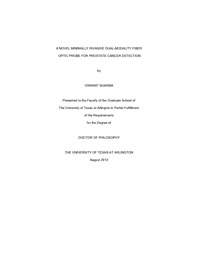| dc.description.abstract | Prostate cancer is the most common form of cancer in males, and is the second leading cause of cancer related deaths in United States. In prostate cancer diagnostics and theapy, there is a critical need for a minimally invasive tool for in vivo evaluation of prostate tissue. Such a tool finds its niche in improving TRUS (trans-rectal ultrasound) guided biopsy procedure, surgical margin assessment during radical prostatectomy, and active surveillance of patients with a certain risk levels. This work is focused on development of a fiber-based dual-modality optical device (dMOD), to differentiate prostate cancer from benign tissue, in vivo. dMOD utilizes two independent optical techniques, LRS (light reflectance spectroscopy) and AFLS (auto-fluorescence lifetime spectroscopy). LRS quantifies scattering coefficient of the tissue, as well as concentrations of major tissue chromophores like hemoglobin derivatives, β-carotene and melanin. AFLS was designed to target lifetime signatures of multiple endogenous fluorophores like flavins, porphyrins and lipo-pigments. Each of these methods was independently developed, and the two modalities were integrated using a thin (1-mm outer diameter) fiber-optic probe. Resulting dMOD probe was implemented and evaluated on animal models of prostate cancer, as well as on human prostate tissue. Application of dMOD to human breast cancer (invasive ductal carcinoma) identification was also evaluated. The results obtained reveal that both LRS and AFLS are excellent techniques to discriminate prostate cancer tissue from surrounding benign tissue in animal models. Each technique independently is capable of providing near absolute (100%) accuracy for cancer detection, indicating that either of them could be used independently without the need of implementing them together. Also, in case of human breast cancer, LRS and AFLS provided comparable accuracies to dMOD, LRS accuracy (96%) being the highest for the studied population. However, the dual-modality integration proved to be ideal for human prostate cancer detection, as dMOD provided much better accuracy i.e., 82.7% for cancer detection in intra-capsular prostatic tissues (ICT), and 92.4% for cancer detection in extra-capsular prostatic tissues (ECT), when compared with either LRS (74.7% ICT, 86.6% ECT) or AFLS(67.1% ICT, 82.1% ECT) alone. A classification algorithm was also developed to identify different grades of prostate cancers based on Gleason scores (GS). When stratified by grade, each high grade prostate cancer (GS 7, 8 and 9) was successfully identified using dMOD with excellent accuracy in ICT (88%, 90%, 85%), as well as ECT (91%, 92%, 94%). | en_US |


